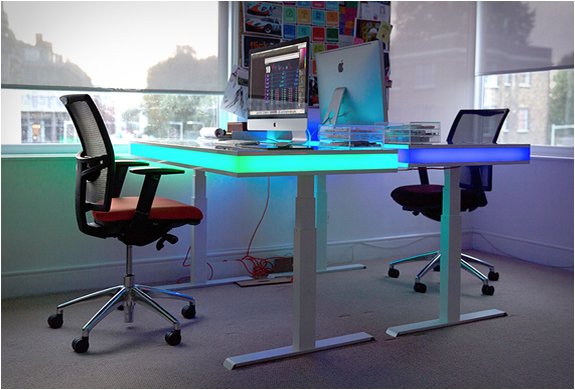The TableAir standing desk rises with a wave of the hand
An innovative standing desk from TableAir gives new meaning to the term “manual labor.” The rectangular desk is outfitted with two distinctive features: ambient LED lighting, and, even more significantly, technology that allows users to adjust the desk’s height with the touch of a button and the wave of a hand, as Slate reports.
“The most natural way of [changing its] height is placing your hand in the air,” explains TableAir’s site. “Smart Button senses the distance to your hand and lifts TableAir to match the height.”

From TableAir
Watch the TableAir in action here. The goal of the desk? To “becom[e] an extension of your movements,” allowing for sit-down or stand-up use. In addition to waving a hand in the air, the desk’s height can also be changed via a smartphone app, which lets users pre-program an automatic change.
How does it work? The desk uses a sensor to spot you and adjust to your position. “When you want to work standing up, you briefly press the button on the top, then hold your hand out in front of you to indicate the desired height. The sensor on top of the desk detects your hand’s height, and the motors move the TableAir up to match it,” explains Wired. The desk can move from about 2 feet to around 4.25 feet. While the desk is adjusting, the ambient LED lights, which line the desktop’s periphery, light up.
The TableAir desk hails from London-based designer Lukas Lukosevicius, who tells Slate that the electric motor technology that powers the desk is smooth and silent. But smooth and silent has a high price tag: $2,146, specifically, for a glossy black or white tabletop, with the cost jumping for American cherry wood or walnut. (One perk, despite the high price tag: the TableAir arrives assembled and ready-to-use.)
Though forward-thinkers like Leonardo Da Vinci, Charles Dickens, and Ernest Hemingway used standing desks, the benefits of standing while working — or, more specifically, not sitting — have been especially hyped recently. Reduced risk of conditions like obesity, type 2 diabetes, cardiovascular disease and cancer, is one of a handful of benefits of limiting sitting time, reported Smithsonian Magazine. As James Levine, an endocrinologist at the Mayo Clinic who has researched the impact of sitting, told the magazine, “The default has become to sit. We need the default to be standing.”
Further, research suggests that exercising will not necessarily balance out an otherwise sedentary lifestyle. As the advocacy group Just Stand notes, “Combating sitting disease with added gym-time may not work: most people don’t have time for more exercise, and more exercise time may not even reverse sitting disease.”
Some tips for integrating standing into your daily routine — aside from opting for a standing desk, of course — include the following, courtesy of Just Stand:
- Walk more while at work
- Stretch and stand every 30 minutes
- Stand up while talking on the phone
- Stand up during your commutes on the bus, train, or subway
- Choose to walk over to colleagues in your office, rather than rely on email
Category: New Products












